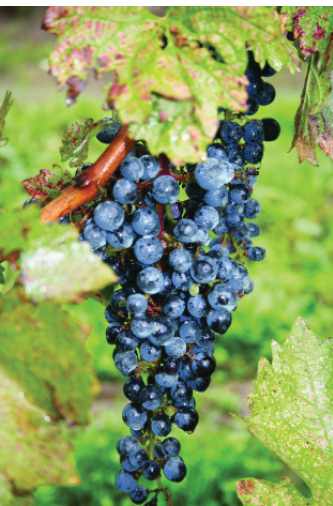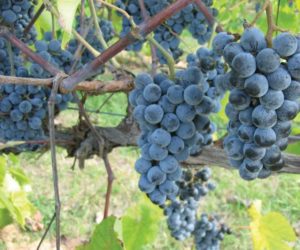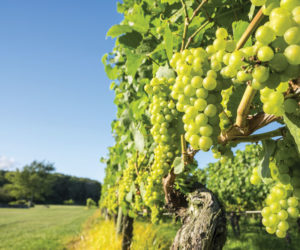
The wines made from Cabernet Sauvignon grapes are as diverse as the lands upon which they are grown. Experience has shown that Cabernet can be successfully grown around the world, but does particularly well with warm growing days and cool nights. This produces wines with black cherry, cassis, plum and herbal characteristics. In cooler areas, some green, vegetative notes, as well as astringency, are pronounced. Hot climates destroy the varietal character, producing unpleasant, unbalanced wines.
Cabernet Sauvignon vines grow well on hillsides as well as in valleys. Optimum conditions for fine wine require lower fertility, but well-drained soils with maximum sunlight exposure. The grapes have been described as “buckshot on barbed wire” because the berries are relatively small and the stems are lignified (woody) at ripeness. Because of its thick skins and loose clusters, Cabernet Sauvignon can tolerate rain very well.
The wines often have such power and tannin that blending with its cousins, such as Merlot, has been a useful tool. Merlot, Cabernet Franc, Malbec and Petite Verdot all can be used as blending tools to give dimension, structure, softness and elegance to the wine. But wines made from 100 percent Cabernet Sauvignon can do quite well on their own. The decision to blend is one of the more exciting challenges faced by a winemaker.
Making Cabernet Sauvignon from Fresh Grapes
Ripe Cabernet grapes have brown, lignified seeds, a gummy skin texture and full flavor development with smooth tannins in the taste. There should be few, if any, green seeds. Degree Brix at harvest can vary tremendously, but it would be advisable to adjust to approximately 23° to 24° Brix, with pH 3.15 to 3.85 and total acidity from 0.5 to about 0.9 grams per 100 ml. The grapes should appear sound and healthy. Be sure to remove overripe, raisined or moldy grapes, plus “MOG” (material other than grapes).
You should make every effort to get grapes from the vine to the fermenter as quickly as possible, and at the coolest possible temperature. The type of equipment can vary greatly, but it is crucial to remove all stems before they get to the fermenter. Beware of tearing skins or breaking seeds throughout the entire process since that will adversely affect the final wine.
The choice of “cold soaking” is up to the winemaker. Basically, cold soaking is the amount of time that grape must is allowed to sit and mix at cool temperatures before the addition of yeast, or before fermentation begins on its own.
Adding sulfur dioxide at the crusher will help avoid bacterial or yeast problems. The recommended amount is usually around 50 parts per million (about 2 grams of potassium metabisulfite per five gallons of juice, or approximately one gram per 40 pounds of fruit).
The type of yeast and the quantity is up to the winemaker, who can determine his ability to control the temperature. Lalvin Brunello Montalcino 45 or EC1118 Prise de Mousse (available from Scott Laboratories in Petaluma, California) are two examples of many recommended yeasts. Be sure the must isn’t too cold when you inoculate with yeast. This is one of the primary causes of stuck fermentation. The must temperature must be above 55° F (13° C) before you add yeast.
I recommend warm temperatures for maximum extraction of color and flavor, but below 90° F (32° C). Maximum punch-down should occur during the prime extraction period from 18° down to 5° Brix. For a vat, thoroughly submerse the “cap” (the skins and grape particles that float on the must) three times a day for about five to ten minutes. Keep it covered with cloth or wood to avoid bugs, and to protect the carbon dioxide blanket on the surface. It is crucial to avoid bitterness by gentle treatment, but thoroughly and frequently wet the cap at this time.
Monitor the aromas and flavors throughout the process to get to know the batch and to determine courses of action: For example, you might detect hydrogen sulfide aromas and decide to aerate. Extended maceration is a matter of taste, but for most home winemakers, pressing at dryness is probably the best bet. Throughout the process, it is crucial to avoid any introduction of stems, shearing of skins, any breakage of seeds, wild swings in temperature, unnecessary oxidation and fruit flies.
Pressing is literally a matter of taste. It is advisable to taste the free run and compare it to the press fractions. As the amount of bitterness and high pH “fatness” increase to a perceived objectionable point, either stop pressing or separate the “hard press.” (You can identify pH fatness by a soapy, oily texture and taste, along with a color change toward brown and dull). See if the bitter/phenoli fractions of this hard press-which usually taste astringent, rough and “puckery”-can be fined to a point at which they taste good and can be returned to the main blend. Fining agents vary from gentle (egg whites) to moderate (casein) to harsh (gelatin or activated carbon). Experimentation in small quantities is the only way to decide the best method.
It’s generally smart to add malo-lactic bacteria at pressing. It is important that the culture is pure. To determine an ideal strain, consult with a supplier. You should avoid growing cultures in a high pH concoction to protect the wine from the introduction of undesirable microbes.
Racking within a few days of pressing is usually a good idea, along with a racking about a week later. At this point, the wine is usually ready to be barreled down and allowed to finish malolactic fermentation. Cabernet Sauvignon is nurtured and allowed to fully evolve with good wood to such a high degree that the importance of high-quality oak cannot be over-emphasized. If you use oak chips, the early addition of well-toasted premium oak chips will allow the wood flavor to integrate and develop.
Topping and tasting on a regular basis is crucial and will give indications of the wine’s condition and development. Closed-in, reduced, stifled characteristics and completion of malolactic fermentation are common indications that the wine needs racking. At this point, decant the wine from the container as carefully as possible. Rinse out the lees from the original container, adjust the free sulfur dioxide level (usually to minimum of 20 ppm, depending on the pH) and return the wine. This regime is normally carried out about once every three months.
Cabernet Sauvignon wines generally improve in the cellar over a period of 15 to 30 months. When the winemaker believes it to be time, the wine should be bottled. Decisions to fine (two or three egg whites per barrel, for example), to blend or to filter should be weighed carefully because they are irreversible. A large egg white measures about 35 ml; for a typical five-gallon batch at home, you’ll want to add about 6 ml of white (keep any particles of yolk out!). For small batches, it’s possible to dilute the egg white with water and add a portion, but remember to mix the white to a light froth with the addition of a few grains of salt.
One caution: Wines usually go through “bottle shock” a week or so after they are bottled. This can be startling if the winemaker isn’t prepared for a disjointed version of a familiar wine. Normally within six to eight weeks the wine will pull out of its awkward phase and begin to give back all the flavors and characteristics the winemaker toiled to preserve.




